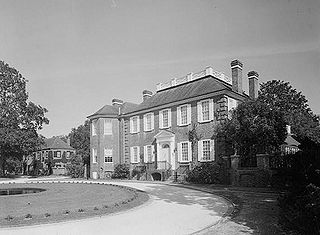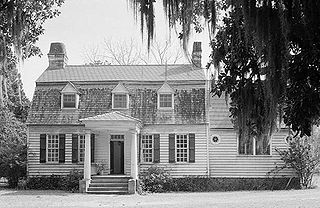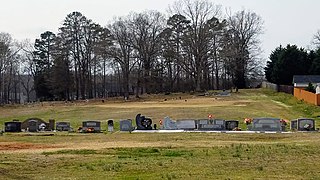
Mount Pleasant is a large suburban town in Charleston County, South Carolina, United States. In the Lowcountry, it is the fourth most populous municipality and largest town in South Carolina, and for several years was one of the state's fastest-growing areas, doubling in population between 1990 and 2000. The population was 90,801 at the 2020 census. It is part of the Charleston metropolitan area.

Mount Auburn Cemetery, located in Cambridge and Watertown, Massachusetts, is the first rural or garden cemetery in the United States. It is the burial site of many prominent Boston Brahmins, and is a National Historic Landmark.

The Charles Pinckney National Historic Site is a unit of the United States National Park Service, preserving a portion of Charles Pinckney's Snee Farm plantation and country retreat. The site is located at 1254 Long Point Road, Mount Pleasant, South Carolina. Pinckney (1757-1824) was a member of a prominent political family in South Carolina. He fought in the American Revolutionary War, was held for a period as prisoner in the North, and returned to the state in 1783. Pinckney, a Founding Father of the United States, served as a delegate to the constitutional convention where he contributed to drafting the United States Constitution.

Boone Hall Plantation is a historic district located in Mount Pleasant, Charleston County, South Carolina, United States and listed on the National Register of Historic Places. The plantation is one of America's oldest plantations still in operation. It has continually produced agricultural crops for over 320 years and is open for public tours.

Edward Brickell White, also known as E. B. White, was an architect in the United States. He was known for his Gothic Revival architecture and his use of Roman and Greek designs.

North Cemetery is a historic cemetery in Worthington, Massachusetts. The 3.5-acre (1.4 ha) municipal cemetery is located at the corner of Cold and North Streets not far from Worthington Corners; it is the town's largest cemetery. The cemetery was listed on the National Register of Historic Places in 2004, for its funerary architecture and its role as the burial ground for the town's early settlers.

The Fenwick Hall, which is also known as Fenwick Castle, is a plantation house built about 1730 on Johns Island, South Carolina, across the Stono River from James Island and Charleston. It is located between River Road and Penneys Creek. It was named to the National Register of Historic Places on February 23, 1972.

The Oakland Plantation House which is also known as Youghall or Youghal Plantation House, was built about 1750 in Charleston County, South Carolina about 7 mi (11 km) east of Mount Pleasant. It is located about 1 mile (1.6 km) south of U.S. Route 17 on Stratton Place. It was named to the National Register of Historic Places on July 13, 1977.

Magnolia Cemetery is a historic rural cemetery in Charleston, South Carolina. The first board for the cemetery was assembled in 1849 with Edward C. Jones as the architect. It was dedicated in 1850; Charles Fraser delivered the dedication address. It was listed on the National Register of Historic Places as a Historic District in 1978.

Christopher W. Werner (1805–1875) was a nineteenth-century wrought iron manufacturer, artisan, and entrepreneur based in Charleston, South Carolina, US. He was one of three noted German-American ironworkers in Charleston, who created most of its high-quality wrought iron. He had immigrated from Prussia in his late 20s, already an accomplished businessman. In Charleston he married a young woman from England, another immigrant, and they had a family.

Remley Point Cemetery is a cemetery located in the Scanlonville community in Mt. Pleasant, South Carolina. It contains 41 marked graves ranging from 1867 to 1989, but residents claim there may be over 1,000 people, largely African American, buried there. It was added to the National Register of Historic Places in 2p02.

Springwood Cemetery is a historic cemetery in Greenville, South Carolina, listed on the National Register of Historic Places. It is the oldest municipal cemetery in the state and has approximately 7,700 marked, and 2,600 unmarked, graves.

Long Point Plantation (38CH321) is a historic plantation site located near Mount Pleasant, Charleston County, South Carolina. The plantation was built sometime between 1719 and 1763, but it came of age during the 19th century. The plantation house and structures were probably built prior to 1763. The plantation was purchased by the prominent Venning family in 1800 and was held by that family until 1899. The main house was apparently razed between 1933 and 1943. One small, brick structure is still standing at the site.

Lucas Family Cemetery is a historic plantation cemetery located near Mount Pleasant, Charleston County, South Carolina. It was established in 1825, and the walled plot includes several grave markers signed by Charleston carvers. Eleven gravemarkers remain, dating from 1825 to 1892, and five are brick box tombs with slab or table tops. The cemetery is significant for being a rare example of traditional family cemetery arrangement in the lowcountry.

Mount Pleasant Historic District is a national historic district located at Mount Pleasant, Charleston County, South Carolina. The district encompasses nine contributing buildings in the town of Mount Pleasant. The dwellings reflect Mount Pleasant's historic role as a summer resort town. The building reflect architectural styles of the 18th, 19th and early 20th centuries, including vernacular Georgian, Greek Revival and Gothic Revival. Notable buildings include the Mount Pleasant Presbyterian Church, St. Andrew's Episcopal Church, Mount Pleasant Seventh-Day Adventist Church, Hibben-McIver House, 200 Bank Street, and the Captain Peter Lewis House. Located in the district is the separately listed Old Courthouse.
The Lawton-Seabrook Cemetery is a small private cemetery at 7938 Steamboat Landing Road on Edisto Island, South Carolina. It is notable for its high-quality brick perimeter wall, and for its funerary markers, which are attributed to local master carver Thomas Walker and his family. There are only seven original gravestones, with additional otherwise unmarked potential graves marked by modern stones.

The Old Pilgrim Baptist Church Cemetery and Kilgore Family Cemetery are a pair of historic cemeteries at 3540 Woodruff Road, southeast of Five Forks, South Carolina. The Kilgore Cemetery houses the remains of several generations of 19th-century plantation owners in the Kilgore family, while the Old Pilgrim Baptist Church Cemetery is an African-American burial ground established in 1868 by former slaves of the Kilgore plantation. The Kilgore Cemetery's funerary markers include several examples cut by W.T. White, a regionally prominent stone cutter.
Carroll City-Mount Olivet Cemetery is a historic site located in Carroll, Iowa, United States. It was listed on the National Register of Historic Places in 2022.



















